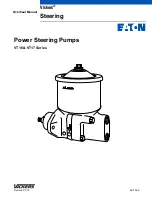
11
B. Inspection, Repair and
Replacement
Discard all used seals and gaskets. Wash all parts in a clean
mineral oil solvent and place them on a clean, lint-free
surface for inspection. Soak new seals and O-Rings in
hydraulic fluid prior to reasembly.
1. Cartridge, Body and Pressure Plate - Inspect all
wearing surfaces for scoring. Light scoring can be removed
from the body and wear plate with crocus cloth or by stoning
or lapping.
Inspect the vanes for wear. Vanes must not have excessive
play in the rotor slots or burred edges. Replace the vanes if
they are defective. Check each rotor slot for sticky vanes or
for wear. Vanes should drop in the rotor slots from their own
weight when both the rotor vanes are dry.
2. Control Valve Sub-Assembly - Check that the valve
moves freely in its bore in the cover and check the valve and
cover bore for excessive wear and scoring. Replace both the
cover and valve sub-assembly if they are deeply scored.
3. Bearing - Replace the bearings if there is any rough-
ness in their action or if any race or ball is pitted, cracked or
scored.
4. Driveshaft and Shaft Seal - Always replace the seal
at overhaul. Check the sealing journal on the shaft for
scoring. Replace the shaft if it is worn; do not install a worn
shaft with a new seal.
5. Body and Cover - Stone the mating surfaces if there
are any burrs or sharp edges. Rewash the parts after
stoning.
C. Reassembly
1. General - Immerse all parts in clean hydraulic oil to
facilitate assembly and prevent damage to seals.
2. Shaft End - Carefully seat the inboard (body) bearing
in the body by pressing on the outer race. Install the
outboard bearing on the shaft by supporting the inner race
and pressing the shaft into it. Using the shaft seal driver
described in Section V-A, page 7, install the shaft seal with
the lip facing inward. Be sure that both bearings and the seal
are properly seated. Lubricate the seal lip with petroleum
jelly and slide the shaft into position. Install the snapring in
the body.
3. Cover End - Support the body on blocks with the
shaft end down before reassembling the pump cartridge and
cover. Coat the two large O-Rings with petroleum jelly and
install them in the grooves in the body and cover.
a. Place the ring against the pump body so that the
cam contour is the same as at disassembly and the arrows
point in the correct direction of rotation. Install the rotor and
insert the vanes in the rotor so that the radiused edges are
against the ring cam. Position the pressure plate over the
locating pins. Be sure the plate is flat against the ring.
b. Insert the spring in the cover bore and install the
control valve, small land toward the cartridge. Install the
cover over the pressure plate and flush against the ring.
Install the cover screws and tighten them to 25-30 foot
pounds torque. Turn the drive shaft through by hand to be
sure it does not bind.
c. VT17 Manifold - Place the manifold gaskets and
spacers on top of the pump and install the manifold and
screws. Torque tighten the screws to 42-48 inch pounds.
d. VT16 Reservoir - Place the gaskets and spacers
on top of the pump and install the tank and tank screws.
Torque tighten the screws to 42-48 inch pounds. Plug the
ports in the pump cover and fill the reservoir with clean
hydraulic fluid poured through a micron filter. Turn the
driveshaft several times in the proper direction of rotation to
fill all the pump chambers and then refill the reservoir.
Install the tank cover gasket and cover. Assemble the bolt
guide and gasket and install the guide in the cover. Assemble
the lockwasher and washer on the cover screw and install and
tighten the screw.
Section VII - Testing of VT16 and VT17 Pumps
Vickers application engineering personnel should be con-
sulted for recommendations on test stand circuit require-
ments and construction. If test equipment is available pumps
should be tested at speeds and pressures shown on installa-
tion drawings. (See Table 1.)





























